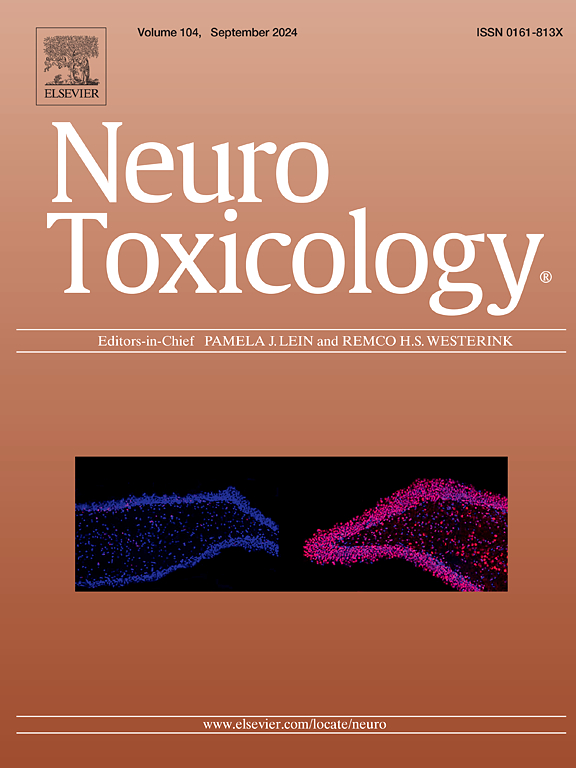鞣花酸对Dmt1摄取和Nrf2防御的双重靶向对抗幼年锰神经毒性。
IF 3.9
3区 医学
Q2 NEUROSCIENCES
引用次数: 0
摘要
锰(Mn)是一种环境神经毒物,通过污染的水威胁儿童健康。我们评估了鞣花酸(EA),坚果/浆果中的一种膳食多酚,对抗多器官锰毒性的潜力。将35只雄性幼年大鼠分为:对照组(蒸馏水)、Mn组(100mg/kg MnCl₂)、EA组(30mg/kg)、给药组和Mn+EA组。口服治疗28 d后进行行为学测试(OFT、EPM、ART)。组织分析氧化应激(SOD、CAT、MDA)、神经炎症(TNF-α)、多巴胺、AChE、基因表达(DMT1、Nrf2、Sod1)和组织病理学。Mn诱导运动缺陷、焦虑样行为、感觉运动高反应性、氧化应激(↓SOD/CAT,↑MDA)、TNF-α升高和多巴胺减少。EA联合治疗逆转了行为障碍,恢复了抗氧化活性,使TNF-α/多巴胺正常化,EA抑制了锰诱导的Dmt1上调(一个关键的代偿性锰摄取途径),同时激活了Nrf2,代表了一种新的双重保护机制。组织学证实EA保留了神经元的完整性,减轻了肝肾损害。总之,ea相关的Dmt1下调和下游生化/组织学改善提供了与锰流入减少一致的间接证据,但需要通过直接脑锰定量来证实。本文章由计算机程序翻译,如有差异,请以英文原文为准。
Ellagic acid’s dual targeting of Dmt1 uptake and Nrf2 defense counters juvenile manganese neurotoxicity
Manganese (Mn) is an environmental neurotoxicant that threatens paediatric health through contaminated water. We evaluated the potential of ellagic acid (EA), a dietary polyphenol in nuts/berries, against multi-organ Mn toxicity. Juvenile male rats (n = 35) were divided into: control (distilled water), Mn (100 mg/kg MnCl₂), EA (30 mg/kg), vehicle, and Mn+EA groups. After 28 days of oral treatment, behavioral tests (OFT, EPM, ART) were conducted. Tissues were analyzed for oxidative stress (SOD, CAT, MDA), neuroinflammation (TNF-α), dopamine, AChE, gene expression (DMT1, Nrf2, Sod1), and histopathology. Mn induced locomotor deficits, anxiety-like behaviour, sensorimotor hyper-reactivity, oxidative stress (↓SOD/CAT, ↑MDA), elevated TNF-α, and reduced dopamine. EA co-treatment reversed behavioural impairments, restored antioxidant activity, normalized TNF-α/dopamine, EA suppressed Mn-induced Dmt1 upregulation, a key compensatory Mn uptake pathway in juveniles, while activating Nrf2, representing a novel dual protective mechanism. Histology confirmed EA preserved neuronal integrity and reduced hepatorenal damage. In conclusion, EA-associated downregulation of Dmt1 and downstream biochemical/histological improvements provide indirect evidence consistent with reduced Mn influx, but requires confirmation by direct brain Mn quantification.
求助全文
通过发布文献求助,成功后即可免费获取论文全文。
去求助
来源期刊

Neurotoxicology
医学-毒理学
CiteScore
6.80
自引率
5.90%
发文量
161
审稿时长
70 days
期刊介绍:
NeuroToxicology specializes in publishing the best peer-reviewed original research papers dealing with the effects of toxic substances on the nervous system of humans and experimental animals of all ages. The Journal emphasizes papers dealing with the neurotoxic effects of environmentally significant chemical hazards, manufactured drugs and naturally occurring compounds.
 求助内容:
求助内容: 应助结果提醒方式:
应助结果提醒方式:


